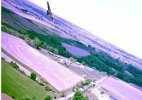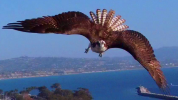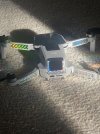I was shooting a neighborhood in Starkville, Mississippi today at 120 meters, and my M3 attracted the attention of a hawk. I quickly dropped down to 35, which was just above the treetops and the hawk moved on to other interests. Anyone have any predator issues from time to time? What are your best suggestions? Thanks!
You are using an out of date browser. It may not display this or other websites correctly.
You should upgrade or use an alternative browser.
You should upgrade or use an alternative browser.
red-tail hawk
- Thread starter SteveMouzon
- Start date
BlairAir
Well-Known Member
The red-taled Hawks LOVE stalking my smaller drones. Air 2, Mini 2. They don't bother the Autel Evo 2 Pro, Mavic 3 or Fimi X8SE too much. More even match I guess.
They hunt in packs or whatever you call them and come into the park where I fly, and roost in trees all around my drone then talk to each other in low raspy tones that sound pretty threatening. I guess I've watched Alfred Hitchcock's "The Birds" too many times lol.
I tried the "shoot straight up to 400 Ft." and thought I was pretty smart. Then I looked up and about 200 feet above that was a big one soaring right above me and checking me the drone out.
Here is a video I caught a couple of them with the Mini 2 one evening when I was just getting into this last year. As to the Red-tailed Hawks; I wouldn't mess with them:
They hunt in packs or whatever you call them and come into the park where I fly, and roost in trees all around my drone then talk to each other in low raspy tones that sound pretty threatening. I guess I've watched Alfred Hitchcock's "The Birds" too many times lol.
I tried the "shoot straight up to 400 Ft." and thought I was pretty smart. Then I looked up and about 200 feet above that was a big one soaring right above me and checking me the drone out.
Here is a video I caught a couple of them with the Mini 2 one evening when I was just getting into this last year. As to the Red-tailed Hawks; I wouldn't mess with them:
- Joined
- Jul 21, 2021
- Messages
- 338
- Reactions
- 411
- Location
- Turning Mill Rd, Lexington, MA, USA
- Site
- www.mintz.net
Hard to tell with the backlighting, but the last bird in the tree looks and acts more like a crow than a hawk. Plus flocking is more of a crow behavior that a hawk behavior.The red-taled Hawks LOVE stalking my smaller drones. Air 2, Mini 2. They don't bother the Autel Evo 2 Pro, Mavic 3 or Fimi X8SE too much. More even match I guess.
They hunt in packs or whatever you call them and come into the park where I fly, and roost in trees all around my drone then talk to each other in low raspy tones that sound pretty threatening. I guess I've watched Alfred Hitchcock's "The Birds" too many times lol.
I tried the "shoot straight up to 400 Ft." and thought I was pretty smart. Then I looked up and about 200 feet above that was a big one soaring right above me and checking me the drone out.
Here is a video I caught a couple of them with the Mini 2 one evening when I was just getting into this last year. As to the Red-tailed Hawks; I wouldn't mess with them:
BlairAir
Well-Known Member
Actually you are correct. As I looked back on it, those aren't Red-tails that soar over much of this area with huge wingspans. Some smaller bird, perhaps crows,, ravens etc.That said, the Red-tailed Hawks in Raleigh NC absolutely hunt in huge groups, up to over a dozen at a time. I have video of them, though not from the drone. Ibwas surprised to see them hunt this way, and when flying, they get more aggressive if I fly down when they track the drone. So far none have had any "direct" interaction with any of my drones, and I hope that never happens. No winners in that scenario.Hard to tell with the backlighting, but the last bird in the tree looks and acts more like a crow than a hawk. Plus flocking is more of a crow behavior that a hawk behavior.
Tomk_
Well-Known Member
There are no hawks, red tailed or otherwise in that video.
You are correct.Hard to tell with the backlighting, but the last bird in the tree looks and acts more like a crow than a hawk. Plus flocking is more of a crow behavior that a hawk behavior.
Most hawks and especially Red Tailed Hawks are solitary until they are a mated pair. From that point they are paired for life but they don't hunt in pairs. When they have eggs they take turns hunting and nesting but they still don't hunt paired.
@BlairAir those look VERY much like Crows and crows do have a low raspy call and are VERY social and very VOCAL.
sancap
Well-Known Member
I have been doing extensive commercial operations for power line/pole equipment where we are often attacked by birds of prey. The best move you can do is to climb straight up. Raptors can descend much better than ascending. It is a proven way to avoid a mid air with an aggressive bird.I was shooting a neighborhood in Starkville, Mississippi today at 120 meters, and my M3 attracted the attention of a hawk. I quickly dropped down to 35, which was just above the treetops and the hawk moved on to other interests. Anyone have any predator issues from time to time? What are your best suggestions? Thanks!
- Joined
- Jul 21, 2021
- Messages
- 338
- Reactions
- 411
- Location
- Turning Mill Rd, Lexington, MA, USA
- Site
- www.mintz.net
That would be an interesting video. Hawks (sometimes several varieties) often gather to share a particularly strong thermal or terrain induced updraft, especially during migration season. But I've never seen them hunt cooperatively.Actually you are correct. As I looked back on it, those aren't Red-tails that soar over much of this area with huge wingspans. Some smaller bird, perhaps crows,, ravens etc.That said, the Red-tailed Hawks in Raleigh NC absolutely hunt in huge groups, up to over a dozen at a time. I have video of them, though not from the drone. Ibwas surprised to see them hunt this way, and when flying, they get more aggressive if I fly down when they track the drone. So far none have had any "direct" interaction with any of my drones, and I hope that never happens. No winners in that scenario.
All that aside, I'm just as happy to stay clear of any crows, hawks, eagles, seagulls, etc. both for their peace of mind and the safety of my drone.
SkywalkerFeng
Well-Known Member
I was shooting a neighborhood in Starkville, Mississippi today at 120 meters, and my M3 attracted the attention of a hawk. I quickly dropped down to 35, which was just above the treetops and the hawk moved on to other interests. Anyone have any predator issues from time to time? What are your best suggestions? Thanks!
One of my previous drone, Mavic 2 Pro, was lost to the Adriatic sea due to seagull attack. After the incident, I did some research online, and here are some of the valuable tips I learnt:
1) when you fly, be aware of the your surroundings. Birds do attack drone, if they think you are flying in their territory.
2) smaller drones are more likely be attacked by birds.
3) when you find your drone under the attack of a large bird, pull up immediately, not pull down.
4) you can either paint your drone a different color or buy brightly colored and reflective tape for the arms and body of the drone. The goal with both is to make the drone look as unnatural as possible, so it does not look like another bird.
Rchawks
Well-Known Member
BlairAir
Well-Known Member
That is a Hawk. I'll leave the crow video in for context. Serves me right for posting when I'm half asleepMy apologies for the poor light color and lighting. I can't seem to get the color balanced. This is from about 2006. I thermaled with this guy for several minutes and this was the only pic I could get (taken with a rc sailplane)View attachment 141909
BlairAir
Well-Known Member
I believe that's exactly what I said after stupidly posting that in a thread about Hawks.There are no hawks, red tailed or otherwise in that video.
Apparently I'm also wrong that the birds we have an abundance of are Red-tailed Hawks. A bit of quick study indicates they're more likely Red-shouldered Hawks!Actually you are correct. As I looked back on it, those aren't Red-tails that soar over much of this area with huge wingspans. Some smaller bird, perhaps crows,, ravens etc.That said, the Red-tailed Hawks in Raleigh NC absolutely hunt in huge groups, up to over a dozen at a time. I have video of them, though not from the drone. I was surprised to see them hunt this way, and when flying, they get more aggressive if I fly down when they track the drone. So far none have had any "direct" interaction with any of my drones, and I hope that never happens. No winners in that scenario.
Red-shouldered Hawk
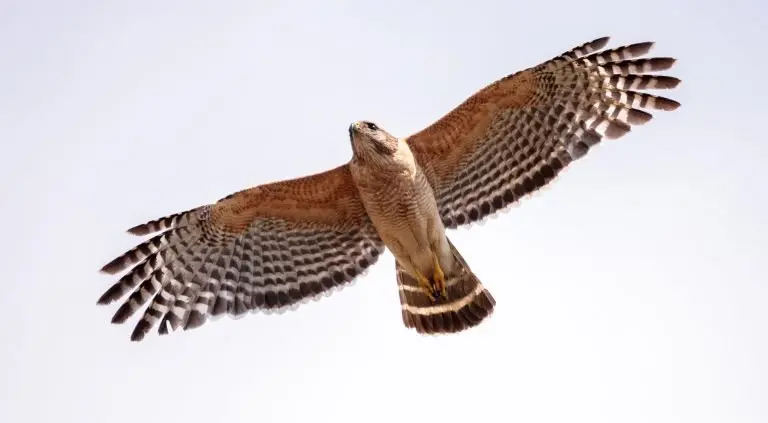
The Red-shouldered Hawk can be found all year in North Carolina but may only be found in winter on the coast. They are quite commonly seen and are in 13% of birding checklists for North Carolina on ebird.org.
Red-shouldered Hawks are distinctly marked, with dark and white checkered wings and reddish barring on the breast. They are medium-sized, between the size of a crow and a swan with a strongly banded tail. They make a loud cack-cack-cack-cack call.
- Length: 16.9-24.0 in (43-61 cm)
- Weight: 17.1-27.3 oz (486-774 g)
- Wingspan: 37.0-43.7 in (94-111 cm)
In any event they look much closer to what I see daily over my area, which is fairly heavily wooded with many lakes & streams. I'll quit while I'm a head before I am told this is incorrect. Heck I'm a drone pilot, not an ornithologist! Be careful up there!
Had a Peregrine come after my drone once when I was near a bridge he was living on. Checked me out and moved on.I was shooting a neighborhood in Starkville, Mississippi today at 120 meters, and my M3 attracted the attention of a hawk. I quickly dropped down to 35, which was just above the treetops and the hawk moved on to other interests. Anyone have any predator issues from time to time? What are your best suggestions? Thanks!
Osprey. I fly all the time where they are and never had one come at me. If you get near their nest it can happen, especially if female is on eggs or with chicks.
Rchawks
Well-Known Member
That's a photo of a lifetime!!!!!! WoW!
Kbviper
Well-Known Member
- Joined
- Jul 18, 2017
- Messages
- 133
- Reactions
- 183
- Age
- 64
I've had both a peregrine falcon and a bald eagle take a run at drones. The bald eagle was near my home and "attacked" a P4P on its first flight. (See my avatar). I headed for home, descending, which was the wrong thing as the eagle dove at the drone and almost caught it before I got home. As others have suggested, going straight up is the best defence as birds of prey cannot usually ascent that fast.
The other encounter was a peregrine falcon making several high speed passes very close to a MA2 before I gained some height and got out of the area.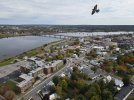
I was impressed by the depth of field in this MA2 shot.
Despite being on the east coast of Canada, and frequently flying near seagulls, I have never had one show any interest in a drone, unlike many others.
Birds are definitely an occupational hazard and responsible for bringing down a number of drones either due to deliberate or accidental contact.
The other encounter was a peregrine falcon making several high speed passes very close to a MA2 before I gained some height and got out of the area.

I was impressed by the depth of field in this MA2 shot.
Despite being on the east coast of Canada, and frequently flying near seagulls, I have never had one show any interest in a drone, unlike many others.
Birds are definitely an occupational hazard and responsible for bringing down a number of drones either due to deliberate or accidental contact.
Good point... hadn't thought of that... thanks!I have been doing extensive commercial operations for power line/pole equipment where we are often attacked by birds of prey. The best move you can do is to climb straight up. Raptors can descend much better than ascending. It is a proven way to avoid a mid air with an aggressive bird.
Similar threads
- Replies
- 24
- Views
- 4K
- Replies
- 18
- Views
- 3K
- Replies
- 11
- Views
- 2K
DJI Drone Deals
New Threads
-
Mini 5 Pro Drone generated pano (21 images) vs Photoshop Pano (21 images)
- Started by Dale D
- Replies: 0
-
-
Panorama question - how do I process 11 and 21 and greater images?
- Started by Dale D
- Replies: 7
-
-
Air 3s (France '25 Part 8) The French Dream - 4K
- Started by ikkel
- Replies: 2
Members online
Total: 2,347 (members: 11, guests: 2,336)




